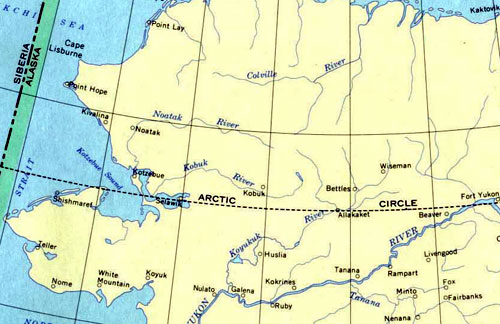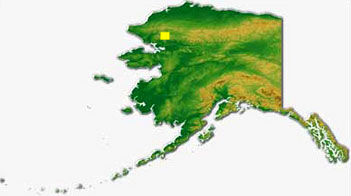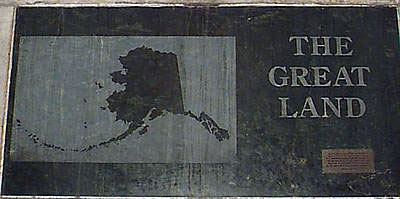 A Legendary Mountain of Jade Just one of Alaska's Arctic Wonders By June Allen October 05, 2004
There are no highways that reach into the far northwest region of Alaska's arctic. Even air travel is restricted to small planes. There are few visitors to the little Eskimo villages along the Kobuk River, a sizeable stream that winds its way along a 200-mile route from its headwaters in the Brooks Range to Kotzebue Sound and the Chukchi Sea. 
There are no contemporary hiking trails or campgrounds along the river's route, but there are small Eskimo villages - Kobuk, Shungnak, Ambler and finally Kiana, the closest to the river's estuary. But this remote Kobuk Valley has been home to people for perhaps 12,000 years! - the date established by carbon dating of artifacts left behind by its ancient inhabitants. Anthropologists are said to agree on that date as being close to the time the North American continent was first inhabited by man.
The oldest house pits were excavated about midway on the Kobuk at the site of a natural portage. They reveal that ancient man had camped here for generation after generation. Great herds of caribou thundered across the river at this crossing during their annual southbound migrations all those thousands of years ago as the animals still do today. Those early hunters left behind evidence of their cultures. And in Alaska that earliest man was an Eskimo. Eskimos are, by definition, people of the sea - subsisting on seals, whales and other creatures of the icy oceans. But some of these early, and some present Kobuk River inhabitants of Alaska required another definition, because they had chosen to expand their cultural choices and had migrated inland, perhaps seasonally, to take advantage not only of the bounty of the ocean but of the woodlands that provided caribou and other game as well. The antecedents of these woodland Eskimos were chosen as subjects of study. Beginning in the late 1930s, the University of Alaska in Fairbanks found the funding to send its own as well as visiting anthropologists to explore and document findings in the Territory's unexplored vastness. Some of them chose to target the Kobuk River not even mapped at the time - because of its unexplored remoteness and its unique woodland Eskimo They were intrigued by stories of a legendary mountain of jade. They had in earlier times heard tales of Gold Rush miners elsewhere in the wilds of Alaska unearthing tusks of woolly mammoths - even those of mastodons. There had been skepticism, but the tales turned out to be true. The mountain of jade also was true! It is one of the westernmost peaks in the Brooks Range, and it is aptly named Jade Mountain - an entire mountain of jade! It is said to be about 150 miles east of Kotzebue, the closest large town. No one person "discovered" the mountain - it had always been there, but the university's scientists documented it. They also recorded a number of legends connected with the amazing mountain.
One of the legends, called The Jade House, tells the story of a poor little boy who visits the home of a neighboring umelik, a rich man. He arrived at dinnertime, but the son of the rich man threw food in the poor boy's face. So the poor boy leaves and later meets the son of an old woman who gives them two magical chin bones so they can fly. They fly to the rich man's house and with their magic powers make his house lean sideways. They ask the rich man for much jade to build a house with, and the umelik agrees if only they will make his fine house stand upright again. They do so and then, using the chin bones, the boys fly themselves and all their jade home again. They are tired from the effort, and while they sleep, the old woman makes them a nice mountaintop house from the jade. The boys awake and see a big house made all of jade! The tale continues, "You can see through the house like a window everything is in the cabin something to eat, something to wear. The boys are umeliks now. And after awhile they are living there, and those other people are getting kind of hungry over there at Jade Mountain. They have no grub in that village. They have a hard time." But the little boy who had food thrown in his face doesn't give them anything to eat. The old story is true, the teller of the legend said, because some tumbled pieces of jade have been found on top of Oksik Mountain, and it's believed to be part of the old jade house the old woman built for the boys. (This story was transcribed by anthropologist J.L. Giddings in his book "Kobuk River People.") Today the presence of Alaska's dark green jade, the gem the Chinese call the Stone of Heaven, is well known. At the signing of Alaska's Constitution by delegates in 1956, the ceremony was lighted by a jade lamp adorned with gold and silver trim. It was provided for the occasion by the Delegate Marvin "Muktuk" Marston - organizer of the World War II Eskimo Scouts who served so proudly during the frightening years of the Alaska theater of war. Then in 1968, the Alaska Legislature named jade as its official State Gem. Specimens are on display all over the state.
Residents and tourists always notice the huge chunk of Alaska jade on display at the entrance to Anchorage's downtown Visitors Bureau on Fourth Avenue. The most notable piece of Alaska jade in the nation's capital is embedded in the interior wall of the Washington Monument, the jade a gift from Alaska in 1982. In Fairbanks this year, a 3,600-pound block of jade from the Kobuk was donated by the NANA Native Corporation to the Fairbanks Police Department. It was erected as part of a memorial to police officers killed in the line of duty. Among the flowerbeds of the manicured grounds of the U of A Fairbanks campus is a jade memorial to the late Kathryn Patty, the gardening wife of early U of A President Ernest Patty. There is modern "legend" dating back to the 1950s that a large block of jade was ordered by Argentina to be used as a memorial to Evita Peron. The story goes that the heavy gemstone was delivered to the Fairbanks, was loaded onto an Alaska Railroad car and carried to the railroad's southern terminus at Seward. However, the story continues, by that time whoever ordered the gemstone had canceled the order because of continuing political upheaval in Argentina - and the jade was shipped back to Fairbanks. No confirmation of that tale has yet been found. And of course Alaska's thousands of summer tourists leave homeward bound with jewelry and trinkets made of Alaska jade from that remote valley in the Arctic. And ancient man, too, picked up nuggets of jade that tumbled downstream in the spring freshets of the Kobuk River. He used the jade for tools and weapons and perhaps for pretty trinkets And some of those artifacts he left behind in house pits, to be found by modern man. As anthropologists in the 1940s through the 1960s trekked across the Kobuk tundra and the woodlands farther inland and canoed down the Kobuk River, they stopped en route to dig at a site downriver from Jade Mountain. It was called Onion Portage, a place where wild onions grew in profusion and caribou herds were said to have crossed the river during their annual migrations from a time "before man's memory." It seemed a logical place to look for evidence of layers of human habitation. And the evidence was there. Visiting anthropologist Louis Giddings of Brown University made a surface investigation of the house pits at Onion Portage before World War II but it wasn't until the 1960s that he began to work the site in earnest. By 1963 there was a large crew of scientists and helpers working at the site, carefully uncovering layer after layer of habitation and collecting the artifacts of each layer's exposure. Onion Portage was, and may still be, the oldest human campsite in Alaska. In one of Giddings' several books he also tells of finds at Cape Krusenstern, now a National Monument on the Arctic Ocean coast just north of Kotzebue. This is a huge, empty and remarkable site of ancient populations far larger than thought possible in an Arctic environment, and of curious cultural customs. One site was found in which the ancient skeletons were found with ivory "spinal columns" holding the vertebra together, and with eye sockets filled with ivory eyeballs! Who were these people? Was there any truth in Eskimo tales of ancient giants? Giddings was killed in a car wreck just a year after his remarkable dig at Onion Portage. But Giddings' books leave readers waiting for the other shoe to drop! Where did these ancient Eskimos originate? Perhaps there are later books or papers by subsequent field scientists working in Alaska? Does the University of Alaska have such works available? Is working in the anthropological field still going on, by the U of A, perhaps by the National Park Service? Is there a list of recommended reading for interested Alaskans? There is no place in the world that can equal Alaska, not only in size and splendor but in unanswered questions.
All rights reserved. Not to be reprinted in any form without the written permission of June Allen.
|








